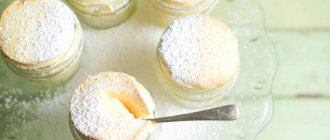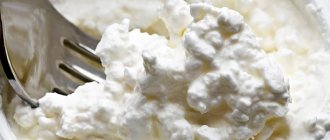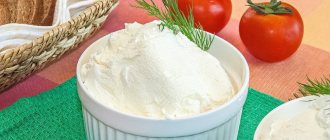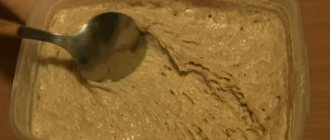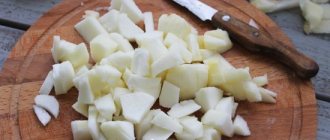What is the difference between homemade cottage cheese and store-bought cottage cheese?
If you just can’t decide which cottage cheese is better - homemade or store-bought, then here’s some advice for you - feel free to give preference to the former.
A homemade product is always more natural, fatty, and the likelihood of finding chemical additives and harmful vegetable fats (like coconut or palm oil) in its composition is much lower.
Unlike homemade cottage cheese, store-bought cottage cheese has a more “chemical” composition. Using harmful additives, unscrupulous manufacturers try to increase weight in an unnatural way (for example, adding starch), as well as extend the shelf life of a short-lived product.
Calorie content of homemade cottage cheese
Homemade cottage cheese is the most delicious. It makes wonderful creams for cakes, fillings for buns, puff pastries and pastries. But this same cottage cheese is the fattest.
The fat content of cottage cheese depends on the fat content of homemade milk. This changes the calorie content of the product. In general, the issue of determining the fat content of homemade cottage cheese is one of the most difficult, so you should always stick to approximate data. And this happens because it’s impossible to simply determine the fat content of homemade cottage cheese. It can be more fatty or less fatty, this can be clearly determined by taste and appearance. But you are unlikely to find out the exact percentage from the owner.
The calorie content of the final product depends on the starting raw materials. Since full-fat cow's milk is used at home, and not dry skimmed milk (like other other components in the production of fermented milk products), the calorie content of cottage cheese is ultimately much higher than that of the store-bought counterpart. Plus, in the process of preparing homemade cottage cheese, cream is added. And this is the fattest part. This is why homemade cottage cheese, unlike store-bought cottage cheese, is soft, yellowish, and not white and crumbly.
Therefore, it is generally accepted that the calorie content of homemade cottage cheese varies from 88 to 230 kcal. Nice spread!
It is believed that low-fat cottage cheese is 0% fat, low-fat - up to 5%, semi-fat - up to 9% and fat - up to 18%. Calorie content changes accordingly. Homemade cottage cheese most often falls into the fatty category. The calorie content of such cottage cheese is 236 kcal.
How to reduce the calorie content of homemade cottage cheese? The question is not for manufacturers
The answer is no. If you can't afford that luxury, skip it altogether. Or dilute low-fat cottage cheese with homemade cottage cheese. You can also add sour fruits such as kiwi, oranges, apples and others. By the way, in this form you can have a very nutritious and tasty breakfast or a snack between lunch and dinner.
Calorie content of low-fat cottage cheese
The energy value of low-fat cottage cheese is about 100 kcal. And this is more than 2 times different from the calorie content of homemade cottage cheese.
This cottage cheese can be eaten with fruit or without anything. But it is not at all suitable for creating creams and desserts. Homemade cottage cheese is perfect for these purposes. It makes ideal cheesecakes, cheesecakes, puff pastries and any homemade baked goods. But this, unfortunately, does not apply in any way to proper and healthy nutrition. But it does taste delicious!
Homemade cottage cheese contains more than just calories
And also a lot of calcium and protein. This is a very valuable product for expectant mothers. And in this case, it is better to really focus on homemade products. And only after childbirth and breastfeeding can you switch to dietary nutrition, if your figure requires it.
Important point! It is good to eat cottage cheese at night. The fact is that it takes a long time to digest in the body. And therefore, it spends its energy on breaking down particles of curd even when you are sleeping. Roughly speaking, you sleep and at the same time lose weight, since energy is spent on processing food. This is the main advantage of cottage cheese. The proteins that are in its composition are used to restore muscle tissue. In this sense, cottage cheese is extremely important in the nutrition of athletes and people involved in any sports.
How long can homemade cottage cheese be stored?
- Fresh cottage cheese should be stored in the refrigerator for no longer than 2 days.
- In a powerful refrigerator (where the temperature does not exceed +8°C) – 4 days.
- In the freezer, the curd retains its beneficial nutritional properties the longest. If the freezing temperature in the freezer reaches -35°C, then the fermented milk product can be stored for about 1-2 months.
- If the freezer temperature does not drop below -18°C, then the shelf life is 2 weeks.
It is best to store fermented milk by wrapping it in foil or parchment.
How much should natural milk, cheese and cottage cheese cost?
Why do low-fat cottage cheese or milk often cost more?
There is no particular reason: the technology for producing low-fat products is not considered more complex, and the components are not considered more expensive.
Low-fat dairy products, on the other hand, should be even cheaper. The fact is that during production, milk fats are separated from milk using a centrifuge and then added to the product in the required quantity. Milk with a fat content of 3.4% is considered basic. Any excess of fats and proteins is paid separately, with fats costing on average 1.5 times more. For example, according to one of the formulas used on the market, every additional 0.1% milk fat costs 30 kopecks, and 0.1% protein costs 20 kopecks.
Olga Orlova , Candidate of Technical Sciences, Associate Professor of the Department of Applied Biotechnologies at ITMO:
— The fact that low-fat products are more expensive is purely fashion. The fattier the product, the more expensive it is to produce. But due to trends - dieting, slim figure, healthy eating - the price of a product that is actually cheaper is increased.
Should products with a short shelf life be more expensive?
As a rule, a short shelf life indicates that the product is natural and the raw materials necessary for its production are more expensive. However, experts note that some manufacturers, due to trends, deliberately set shorter shelf life to attract buyers, while continuing to use raw milk with low quality indicators.
A short shelf life imposes additional risks, which the company can reflect in the cost, but the price should not differ several times. Even with an extended shelf life, the final cost of the product depends on the processing technology chosen by the manufacturer.
Vsevolod Vishnevetsky , Chairman of the St. Petersburg public consumer organization “Public Control”:
— There is milk that does not undergo heat treatment, but microfiltration. This is a very expensive technology: milk is passed through a very fine filter, which traps all bacteria. As a result, all the beneficial components of this milk are preserved. It is stored for about a month.
Which dairy product is the most expensive?
Cheese. Firstly, it requires a large amount of raw milk - 8–12 liters per kilogram, depending on the type.
Secondly, the production process itself takes a longer time: the ripening period of cheeses can range from a month (for semi-hard cheeses) to several years (for hard ones). Throughout the entire period, the product requires certain conditions: the humidity and temperature necessary for ripening are maintained in special chambers.
Another rather expensive product is cottage cheese. Its production also requires large volumes of raw materials, from 6 to 8 liters per kilogram. Some cottage cheese is produced using elements of manual labor, which also affects its cost.
How do stores set prices for dairy products and what does this depend on?
Retail chains set their own prices for dairy products—manufacturers can only recommend an approximate cost. On average, the markup is 15–30%, but this depends on the specific network. For example, premium supermarkets can double the price, while ordinary chains will need a 20% markup.
Alexander Maurer , co-owner:
— Retail networks focus on each other. There are some indicative products that people pay attention to, and retailers are fighting for them. Everyone has their own sales strategy. Let's say we had cases when a chain temporarily supplied our goods with virtually no markup, that is, even cheaper than in our branded stores. This is how they attracted clients.
In addition, notes ITMO specialist Olga Orlova, in some cases the markup depends on how well the supplier complies with the requirements of the retail chain, which can be quite stringent. “It’s easier for corporations: they are more stable and have uninterrupted supplies, so prices can be lower there. And a small manufacturer sometimes cannot fulfill all these points, so the price will be higher,” she says.
What is considered too cheap and what is too expensive milk?
The minimum price of products can be calculated based on the average cost of raw milk. Let's say, if in the Leningrad region it costs 28–29 rubles for 1 kg of premium raw milk, then a liter box in a store is unlikely to cost less than 70 rubles, taking into account all the costs of production and transportation. If the product is made not exclusively from raw materials, but using powdered milk, then, of course, the price will be lower. According to Petrostat, at the beginning of 2020 the average retail price for milk was 62 rubles, but we are talking about milk with any composition and production method.
If a dairy product is suspiciously cheap, then perhaps you are looking at a counterfeit product. Or the manufacturer deliberately lowered the price - say, by including profit in the cost of another product or for marketing purposes. However, even in this case it is unlikely to be less than the cost.
Vsevolod Vishnevetsky , Chairman of the St. Petersburg public consumer organization “Public Control”:
— Of course, the price speaks volumes about the quality. If it is lower than the market average, then most likely the manufacturer and seller are deceiving you - for example, the raw materials in the product were deliberately replaced. A pack of butter weighing 180 grams on a store shelf today cannot cost less than 100 rubles - these are the costs of production, logistics, packaging and sales of this product.
To create the illusion that the product is not becoming more expensive, dairy producers can also resort to various tricks: for example, pouring 900 ml of milk into liter bottles. And although this is indicated on the packaging, visually it seems that there is more product than there actually is.
The upper price limit is set by the market, so it is difficult to name the limit of what is acceptable here.
How much fat is in homemade cottage cheese?
Another difference between homemade cottage cheese and store-bought cottage cheese is its fat content. This indicator depends on the technology for preparing the product and the raw materials from which it is made.
Based on this, homemade cottage cheese comes in 3 types of fat content:
- – made from selected whole milk, the fat content of which is at least 18%; fatty
- semi-fat
(fat content – 9%) – produced on the basis of whole and skim milk at the same time; - skim
– made exclusively from skim milk – milk from which the cream has been skimmed. This fermented milk product has the smallest fat reserve - only 0.5%. Low-fat cottage cheese is best suited for diets; moreover, it is easier for the body to digest than other types.
The percentage of fat in a fermented milk product directly affects its calorie content. If you don’t know how to count calories in cottage cheese and how to determine how much protein, fat, and carbohydrates it contains, then we bring to your attention a simple but detailed calorie table.
Calorie content of low-fat cottage cheese (from 2 percent to 5 percent)
For people who are trying to reduce their weight, it is better to eat low-fat cottage cheese. You can find low-fat cottage cheese on store shelves. This product contains pure protein, but its absorption in the body is poor, since there is no necessary milk fat.
During the process of skimming, vitamins such as A, D, E disappear from milk. This is due to the fact that these vitamins are fat-soluble, and during the process of removing unnecessary fat, they are removed along with it. As a result, the product turns out to be less nutritious and healthy.
To make eating cottage cheese healthy, it is better to choose a product that contains fat, at least in small quantities. Ideal in this case would be low-fat cottage cheese, which can contain from 2% to 5% fat.
100 grams of cottage cheese with two percent fat content contains:
- proteins 18 grams;
- fat 2 grams;
- carbohydrates 3.3 grams.
Low-fat cottage cheese has the same set of minerals as other types of this product . In industrial conditions, manufacturers can add additional vitamin and mineral supplements to it, which is indicated on the packaging.
With the constant consumption of low-calorie cottage cheese, it is necessary to introduce other products into the diet that could compensate for the lack of vitamins and nutrients.
The calorie content of a 100-gram serving of cottage cheese with 2% fat is 103 kcal.
If the fat content of the product is higher, then the calorie content will increase slightly. Five percent cottage cheese contains:
- protein 17.2 grams;
- fat 5 grams;
- carbohydrates 1.8 grams.
The energy value per 100 grams of five percent cottage cheese is 121 kcal.
The calorie content of low-fat cottage cheese from different manufacturers can vary significantly; its value can be from 95 to 115 kcal . This difference occurs as a result of the use of various additives or sugar, which gives low-fat cottage cheese improved taste. Therefore, before purchasing a finished product, carefully study the packaging, which indicates the composition and calorie content .
To be sure of the quality of the cottage cheese, you can make it yourself. Low-fat cottage cheese is made from skim milk. To make it at home, you need to ferment milk with the desired percentage of fat content.
Calorie content and nutritional value of homemade cottage cheese
To determine how many grams of protein, fat and carbohydrates are in homemade cottage cheese, you don’t have to do complex calculations yourself. Use ready-made data.
The calorie table shows not only kilocalories per 100 g of product, but also the nutritional value of each of the 3 types of fat content of fermented milk product.
Using a simple table, you will always know how many carbohydrates, protein and fats are contained in homemade cottage cheese purchased or prepared by you.
This knowledge will be useful to you, especially if you calculate each of your daily kilocalories and create a detailed dietary menu for every day.
What milk should I use to make homemade cottage cheese?
When answering the question of how much cottage cheese is produced from 1 liter of milk, one cannot help but tell you exactly what raw materials are needed to make such a product.
The best option for making delicious homemade cottage cheese is whole cow's milk. It is advisable to purchase it at the market from villagers. After all, only from a natural drink with maximum fat content you will get tender and tasty cottage cheese.
As for the milk that is sold in the store, it is extremely rarely used to prepare fermented milk products. This is due to the fact that in most cases such a drink is made from powder.
How to determine the naturalness of cottage cheese at home
All of us, one way or another, are faced with the deception of a commodity producer, and this deception may consist in adding starch to the composition of the product (in order to increase the weight of the curd mass) and vegetable fats, thanks to which the production of goods becomes less financially costly for the manufacturer.
Both can have an extremely negative impact on our health. To minimize risks and not waste money, we offer you several simple ways to check the quality of cottage cheese at home.
Method number 1: check the cottage cheese for the presence of starch in it
It will not be difficult to identify starch in homemade cottage cheese. All that is needed to expose a shoddy product is a couple of drops of regular iodine.
You need to drop iodine onto a piece of curd mass, and then look at the result: if the iodine on the curd turns blue, then the product contains starch, but if iodine remains in its usual light yellow color, then the product does not contain starch.
Method No. 2: determine whether there are vegetable fats in the cottage cheese
Organoleptic method
The first thing you can do is try cottage cheese. If it contains vegetable fats that are undesirable for us, then an oily taste and a feeling of the presence of a “fatty film” will remain on the tongue.
Presence of vegetable fats
You can also check the product for the presence of vegetable fats using warm water. To do this, you will need to add 1 tsp to a glass of warm water. fresh cottage cheese, gently stir it and leave for a couple of minutes.
If during this time a yellowish film appears on the surface of the water, and the cottage cheese settles to the bottom, do not doubt that it contains fats.
Is it worth eating only low-fat cottage cheese?
Low-fat cottage cheese has 18% protein, regular cottage cheese has 16%, while full-fat cottage cheese contains only 14%. In this regard, you should choose between them based on the amount of fat and protein your body requires. It is especially important to monitor this indicator for athletes and people trying to cope with excess weight.
If the body needs to restore energy, you will have to eat much more low-fat cottage cheese, because low fat content impairs the absorption of nutrients. For example, if we talk about the very calcium that is considered the key benefit of cottage cheese, then it will be absorbed from low-fat cottage cheese by approximately 30-40% less in comparison with classic one. Calcium is well absorbed due to the presence of fat-soluble vitamin D in the product, but it is present in the required amount only in products with medium and high fat content.
If you consume cottage cheese with low fat content, then animal fat must be added to your diet from other food products. After all, it takes part in the release of hormones, the structure of brain cells and the nervous system, and also normalizes thermoregulation.
By completely getting rid of animal fats, after just a couple of weeks you will notice that your hair, nails and skin have lost their former freshness. In addition, this will lead to brittle nails and significant noticeable drying of the skin. The feeling of tightness and peeling will make itself felt. All this suggests that you can’t joke with low-fat food products; you should be more careful in your choice, because your health will depend on it.
If you still want to eat a lot of low-fat cottage cheese, it will be useful to know that when preparing it, manufacturers often do not hesitate to add starch. The taste is improved with the help of sweeteners and flavors. After all, natural low-fat cottage cheese does not have a pronounced taste and is very dry.
